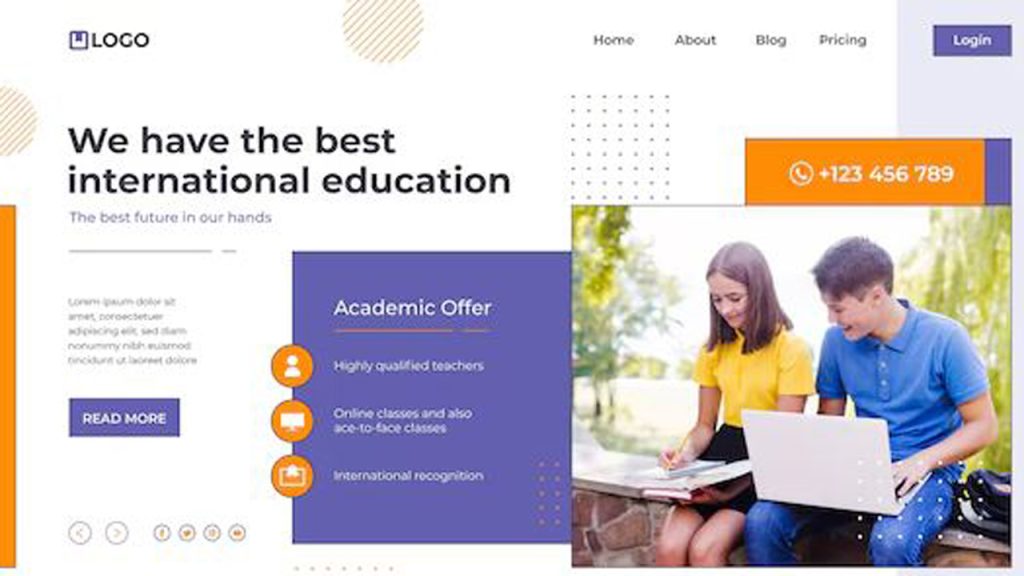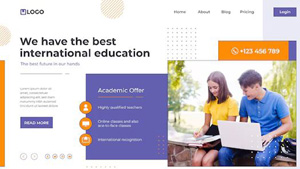In today’s digital age, creating an educational website has become more important than ever. Whether you are a teacher, an educational institution, or an online learning platform, having a strong online presence is crucial for reaching and engaging with your target audience. But how do you go about creating a successful educational website that not only educates but also captivates? This article will guide you through the key steps and strategies to create an educational website that stands out from the competition.
From choosing the right design and layout to integrating interactive elements and optimizing for search engines, we will explore everything you need to know to ensure your website delivers a seamless and enriching learning experience. So, whether you’re looking to share educational resources, offer online courses, or provide tutoring services, get ready to unlock the potential of your educational website and make a lasting impact on your learners.

Image by freepik
Importance of an Educational Website
In digital world, an educational website has become an essential tool for educators and learners alike. The traditional classroom setting is no longer the sole source of education, as people are increasingly turning to online platforms for learning. An educational website provides a convenient and accessible way for learners to access educational materials, engage in interactive learning experiences, and connect with educators and peers.
Having an educational website allows educators to extend their reach beyond the physical limitations of a classroom. It enables them to share their expertise, knowledge, and resources with a global audience, making education accessible to learners from all walks of life. By embracing technology and creating an educational website, educators can enhance the learning experience, foster collaboration, and empower learners to take control of their education.
Creating an educational website opens up a world of possibilities for both educators and learners, and it is essential to understand the significance and potential impact of such a platform.
Defining Your Target Audience
Before diving into the process of creating an educational website, it is crucial to define your target audience. Understanding who your website is designed for will help you tailor your content, design, and overall user experience to meet their specific needs and preferences.
When defining your target audience, consider factors such as age, education level, interests, and goals. Are you targeting school-age children, college students, or professionals seeking to upskill? Are you focusing on a specific subject area or offering a broad range of educational resources? Once you have a clear understanding of your target audience, you can start crafting your website’s content and design to effectively engage and resonate with them.
Planning Your Website Structure
After defining your target audience, the next step is to plan your website structure. A well-organized and intuitive website structure is essential for easy navigation, ensuring that your visitors can find the information they need without any confusion or frustration.
Start by creating a logical hierarchy of pages and sections. Consider the different categories of educational content you will offer and how they will be organized. For example, if you are an online language learning platform, you may have separate sections for vocabulary, grammar, and pronunciation. Within each section, further divide the content into relevant subtopics. This hierarchical structure will provide a clear and organized user experience, allowing learners to navigate your website effortlessly.
Consider incorporating a search function and intuitive navigation menus to further enhance the usability of your website. A well-planned website structure sets the foundation for a seamless learning experience and keeps your visitors engaged and motivated to explore more.
Choosing the Right Content Management System (CMS)
When it comes to building an educational website, choosing the right content management system (CMS) is crucial. A CMS is a software application that allows you to create, edit, and manage digital content without the need for extensive coding knowledge. It provides a user-friendly interface that simplifies the process of creating and maintaining your website.
There are several CMS options available, each with its own set of features and capabilities. Popular CMS platforms like WordPress, Drupal, and Joomla offer a wide range of themes, plugins, and customization options specifically designed for educational websites. Consider factors such as ease of use, scalability, security, and community support when selecting a CMS that best suits your needs.
Once you have chosen a CMS, familiarize yourself with its features and functionalities. Learn how to create and publish content, customize the design, and manage user accounts. A good understanding of your CMS will empower you to create and maintain a professional-looking educational website with ease.
Designing a User-Friendly and Visually Appealing Website
The design of your educational website plays a crucial role in capturing and retaining your visitors’ attention. A user-friendly and visually appealing design enhances the overall learning experience and encourages learners to stay engaged with your content.
When designing your website, aim for a clean and uncluttered layout. Use a consistent color scheme that aligns with your brand and creates a visually pleasing atmosphere. Avoid overwhelming your visitors with too much information on a single page, and instead, break up content into easily digestible sections. Incorporate ample white space to improve readability and focus attention on key elements.
In addition to aesthetics, ensure that your website is user-friendly and accessible on different devices. With the increasing use of mobile devices, it is crucial to optimize your website for mobile responsiveness. This ensures that learners can access your content anytime, anywhere, using their preferred device.
Consider conducting user testing to gather feedback on your website’s design and usability. This will help identify any potential issues or areas for improvement, allowing you to refine your design and provide an optimal learning experience for your visitors.
Creating High-Quality and Engaging Educational Content
The content you provide on your educational website is the heart of your platform. It is what attracts and engages learners, and ultimately determines the success of your website. Creating high-quality and engaging educational content should be a top priority.
Start by conducting thorough research on the topics you plan to cover. Ensure that the information you provide is accurate, up-to-date, and relevant to your target audience. Use credible sources and cite your references to establish trust and credibility.
When creating educational content, aim for a conversational tone that is easy to understand. Break down complex concepts into simple and relatable terms to make learning more accessible. Incorporate visuals, such as images, infographics, or videos, to enhance understanding and engagement.
Consider incorporating interactive elements into your content to make the learning experience more immersive and interactive. This could include quizzes, interactive simulations, or discussion forums where learners can engage with each other and the content. Interactive features not only enhance engagement but also promote active learning and knowledge retention.
Regularly update and expand your educational content to keep it fresh and relevant. Listen to feedback from your learners and address any gaps or areas of improvement. By consistently delivering high-quality and engaging content, you will establish your educational website as a trusted source of knowledge and attract a loyal audience.
Implementing Interactive Features and Tools
To create an enriching learning experience, consider implementing interactive features and tools on your educational website. These features go beyond static content and allow learners to actively engage with the material, promoting deeper understanding and knowledge retention.
One popular interactive feature is discussion forums or chat rooms where learners can ask questions, share insights, and engage in discussions with peers and instructors. This fosters community and collaboration, creating a supportive learning environment.
Another effective interactive tool is the use of quizzes and assessments. These can be used to test learners’ understanding of the material and provide immediate feedback. Gamification elements, such as badges or leaderboards, can be incorporated to motivate learners and make the learning process more enjoyable.
Consider integrating multimedia elements such as videos, audio recordings, or virtual reality experiences. These interactive tools provide a multi-sensory learning experience that appeals to different learning styles and enhances engagement.
When implementing interactive features and tools, ensure that they are intuitive and user-friendly. Test them thoroughly to ensure they function as intended and provide a seamless learning experience. Interactive elements have the potential to elevate your educational website and make it a dynamic and engaging platform for learning.
Optimizing Your Website for Search Engines
To ensure your educational website reaches its intended audience, it is crucial to optimize it for search engines. Search engine optimization (SEO) techniques can help improve your website’s visibility and ranking in search engine results, making it easier for learners to discover your content.
Start by conducting keyword research to identify the terms and phrases your target audience is likely to search for. Incorporate these keywords naturally into your website’s content, including headings, titles, and meta descriptions. This will help search engines understand the relevance of your content and rank it accordingly.
Optimize your website’s loading speed by compressing images, minifying code, and enabling browser caching. A fast-loading website not only improves user experience but also improves your search engine ranking.
Ensure that your website is mobile-friendly and responsive to different screen sizes. With the increasing use of mobile devices, search engines prioritize mobile-friendly websites in their search results.
Build quality backlinks by reaching out to other educational websites, blogs, or influencers in your niche. Guest posting or collaborating on content can help drive traffic to your website and improve your search engine ranking.
Regularly monitor your website’s analytics to track your SEO efforts and identify areas for improvement. SEO is an ongoing process, and staying up to date with the latest trends and algorithms is crucial to maintaining and improving your website’s visibility.
Promoting Your Educational Website
Creating an educational website is just the first step. To ensure its success, you need to actively promote it and attract your target audience. Here are some effective strategies for promoting your educational website:
- Utilize social media platforms to share informative and engaging content. Create social media accounts for your website and regularly post updates, educational resources, and announcements. Engage with your audience by responding to comments and questions.
- Collaborate with other educational influencers or organizations in your niche. Guest post on their websites, participate in webinars, or conduct joint marketing campaigns. This can help expand your reach and attract new learners to your website.
- Leverage email marketing to stay connected with your audience. Offer a newsletter where you can share exclusive content, updates, and special offers. Encourage visitors to subscribe to your newsletter by providing valuable incentives or free resources.
- Invest in paid advertising, such as Google Ads or social media ads. This can help increase your website’s visibility and attract targeted traffic. Set a budget and carefully target your ads to reach your ideal audience.
- Engage in search engine marketing (SEM) by bidding on relevant keywords to appear in search engine ads. This can help drive targeted traffic to your website and increase brand awareness.
- Collaborate with influencers or bloggers in your niche by providing them with access to your educational resources or offering to write guest articles for their websites. This can help you tap into their existing audience and attract new visitors to your website.
Remember to track and analyze your promotional efforts to identify what strategies are most effective for your website. Adjust your marketing strategies accordingly to maximize your reach and impact.
Conclusion
Creating an educational website is a powerful way to share knowledge, engage learners, and make a lasting impact on the education landscape. By following the key steps and strategies outlined in this article, you can create an educational website that stands out from the competition and provides a seamless and enriching learning experience.
From defining your target audience and planning your website structure to creating high-quality content and optimizing for search engines, each step is essential for success. Embrace technology, unleash your creativity, and unlock the potential of your educational website to shape the future of education.
Building an educational website is an ongoing process. Continuously assess and improve your website based on user feedback, technological advancements, and emerging trends. Stay committed to delivering exceptional educational content and providing a user-friendly experience. With dedication, creativity, and the right strategies, your educational website can become a valuable resource for learners around the world.




